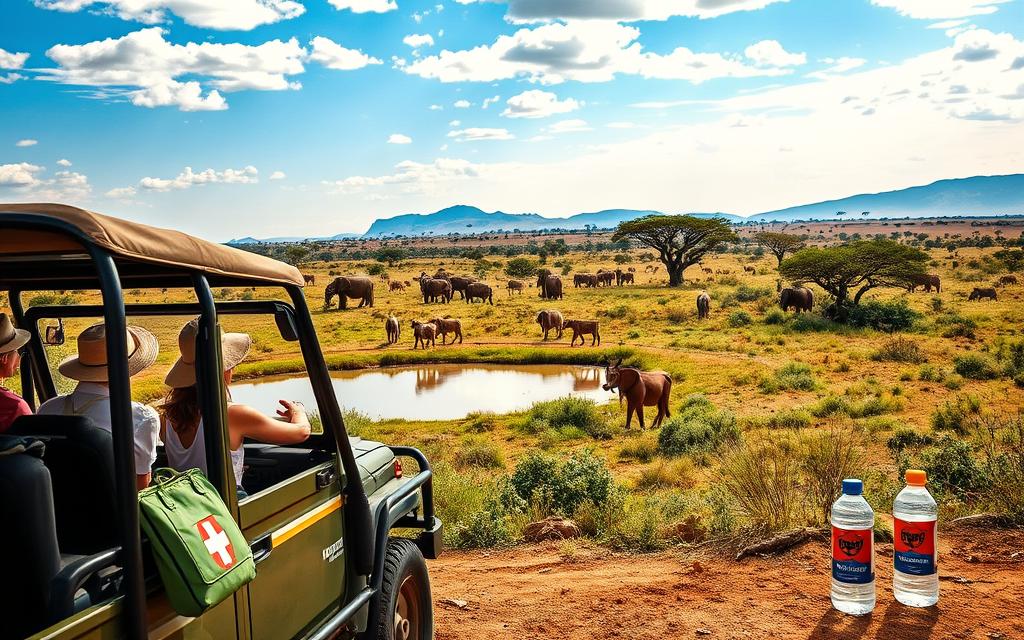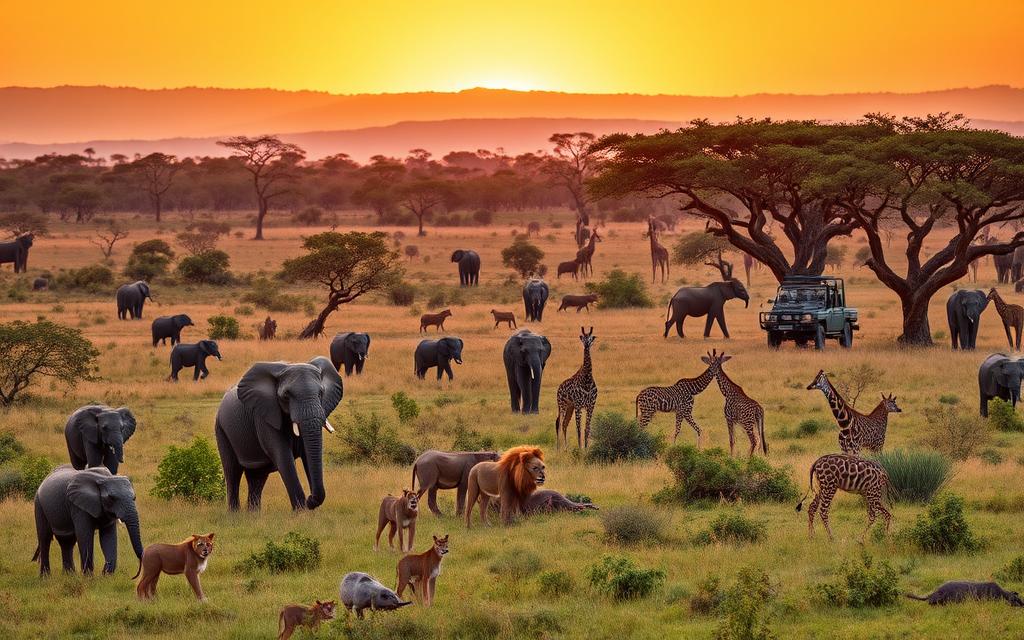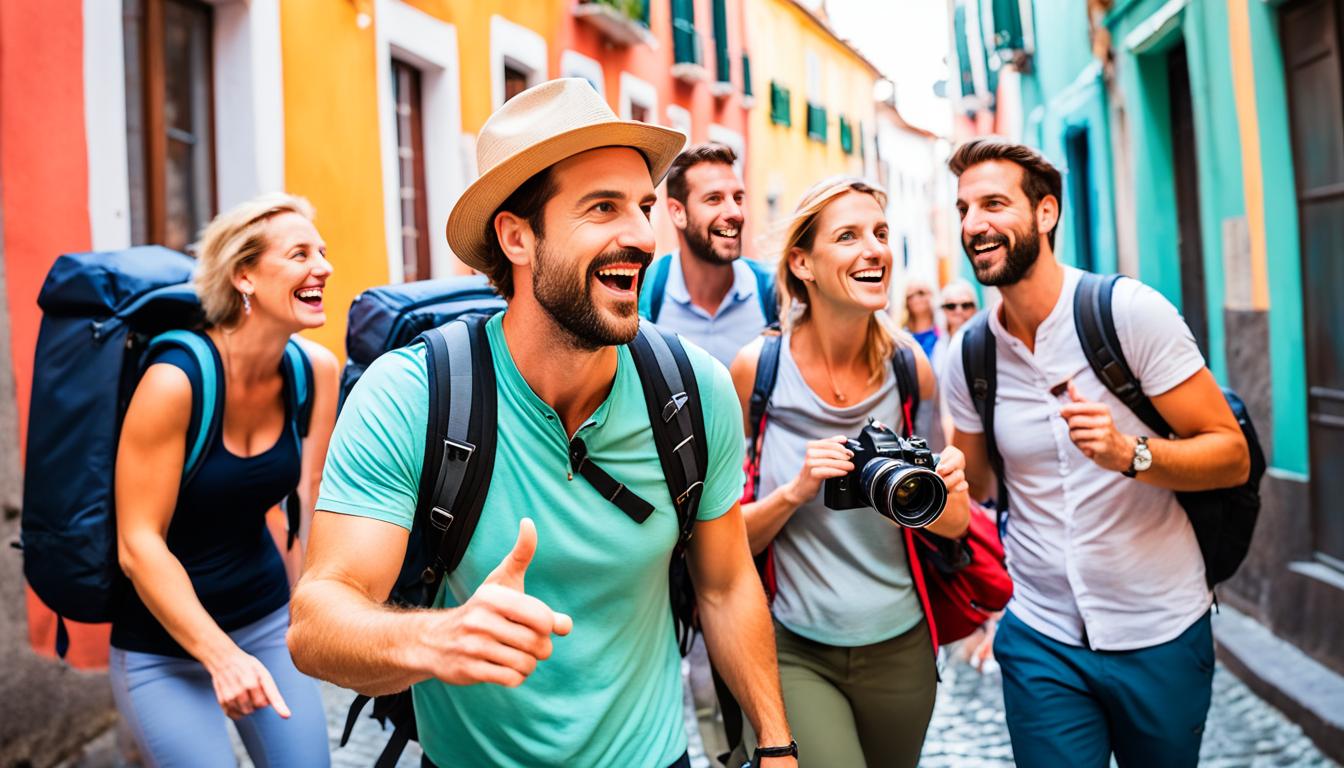Kenya is known as a top safari spot, but many wonder: Is Kenya safe for wildlife tourism? The good news is that Kenya’s main safari areas are very safe. Places like the Masai Mara and Amboseli have a great safety record. Many tourists visit these spots every year without worry.
But, there’s more to the story. Cities like Nairobi face more crime, but this crime rarely reaches the wildlife reserves. Experts say that Kenya wildlife safety is mostly good in the main tourist areas. These areas are far from the city crime spots.
The Kenyan government and its international partners have worked hard to keep wildlife areas safe. They’ve added more security, special ranger teams, and constant checks. All these efforts help make Kenya a secure place for wildlife lovers.
Still, it’s wise to be careful in cities and stay away from risky areas. But, Kenya wildlife tourism is mostly safe. It offers a unique chance to see amazing wildlife and beautiful landscapes.
Understanding Kenya’s Wildlife Tourism Landscape
Kenya’s wildlife tourism is a big part of its economy. It adds 7% to 10% of the GDP each year. With 6% growth in wildlife safaris, it’s clear Kenya is a top choice for wildlife tourism.
Overview of Wildlife Attractions
Kenya is known for its rich wildlife. It has about 30,000 different species of animals and plants. This includes 1,100 bird species, 315 mammals, and 191 reptiles.
Whether you love birds or big cats, Kenya has something for everyone. Its diverse habitats, like savannahs and highlands, make it a hotspot for wildlife. Places like Amboseli and Meru attract many visitors each year.
Popular National Parks and Reserves
Kenya has 23 national parks and 28 national reserves. The Maasai Mara is a top spot, famous for the Great Migration. It offers unique wildlife experiences that attract visitors worldwide.
The Samburu National Reserve is another gem, known for its wildlife and cultural experiences. Laikipia offers a mix of biodiversity. Tsavo, Meru, and Nairobi National Park are great for seeing elephants, rhinos, and more.
| Park/Reserve | Special Features | Main Wildlife |
|---|---|---|
| Maasai Mara | Great Migration | Lions, Wildebeest, Zebras |
| Amboseli | Views of Mt. Kilimanjaro | Elephants, Giraffes, Buffaloes |
| Samburu | Samburu Special Five | Reticulated Giraffe, Grevy’s Zebra |
| Lake Nakuru | Flamingo Population | Rhinos, Flamingos |
| Tsavo | Elephant Herds | Elephants, Hippos, Crocodiles |
Kenya’s wildlife tourism shows off its natural beauty and diversity. These top spots offer amazing chances to see nature’s wonders. It’s a journey worth taking for any traveler.
Safety Measures in Kenyan Wildlife Tourism
Kenya has set up a detailed plan to keep tourists safe in its famous wildlife spots. These steps are taken to ensure a safe and fun trip for all.
Government Regulations
The Kenyan government focuses a lot on safari safety in Kenya. They have put in place many rules and safety steps to protect both visitors and animals. With soldiers in key places and safe zones in tourist areas like the Mara-Serengeti, safety is a big deal. The tourist police help keep visitors safe, solve crimes, and guide during cultural events.
| Regulation | Details |
|---|---|
| Active Military Presence | Ensures security in critical areas. |
| Peaceful Zones | Maintaining secure areas in popular tourist regions like the Mara-Serengeti. |
| Tourist Police Unit | Dedicated team for protecting tourists and investigating crimes. |
Tour Operator Safety Protocols
Good tour operators in Kenya follow strict safety rules. These rules match local and international standards to keep tourists safe. Since 1998, the Kenya Tourism Federation Safety and Communication Centre watches over security and sends out alerts. This builds trust in the tourism industry.
Popular tour operators follow these safety steps:
- Controlled Access
- Highly Trained Guides
- Emergency Response Plans
- Regular Safety Drills
The mix of government safety measures in Kenya and strict tour operator rules makes Kenya a safe place for millions of visitors each year. This is why Kenya is a top pick for wildlife tourism worldwide.
Common Wildlife Encounters
Kenya is a paradise for wildlife lovers, with many amazing species seen on safaris. You can spot the Big Five in Kenya and watch the incredible migration of wildebeests and zebras. The variety of wildlife here offers endless chances for unforgettable moments.
Big Five and Other Iconic Species
When you go on a wildlife tour in Kenya, you’ll see the Big Five. These are lions, elephants, buffalo, leopards, and rhinos. The Maasai Mara National Reserve is the best place to see all of them, especially during the migration.
Elephants are also a big draw, with large herds in places like Amboseli National Park. They show off their family structures and behaviors. Giraffes, including the rare Rothschild’s giraffe, are common in Kenya. Hippos and hyenas are also seen, with cheetahs and leopards being a thrill for those who can spot them.
Interaction Guidelines for Tourists
There are strict rules to keep both wildlife and tourists safe. These rules help protect animals and their habitats. Visitors should stay far from animals, be quiet, and listen to their guides.
Following these guidelines helps ensure safe wildlife viewing in Kenya. It also helps protect these amazing animals and supports conservation efforts. This way, the incredible experience of seeing the Big Five in Kenya can continue for years to come.
| Animal | Frequency of Sightings |
|---|---|
| Lions | Common |
| Elephants | Common |
| Buffalo | Common |
| Leopards | Occasional |
| Rhinos | Rare |
| Giraffes | Common |
| Hippos | Common |
| Hyenas | Common |
| Cheetahs | Occasional |
| Wild Dogs | Very Rare |
Travel Health and Safety Tips
Planning a trip to Kenya means knowing about health and safety steps. Kenya is known for its amazing wildlife, but it’s key to be aware of health risks. Taking the right precautions is crucial for a safe and fun trip.
Recommended Vaccinations
Before you go to Kenya, check the vaccinations you need. Malaria is a big worry, so take your meds and use bug spray. Also, get shots for hepatitis A and B, typhoid, and yellow fever. These shots help protect against diseases spread by water and bugs.

Health Precautions and Emergency Contacts
Following health tips for Kenya can greatly improve your trip. Avoid swimming in fresh water to prevent diseases like schistosomiasis. Always use water purification when camping or hiking.
Heat can also be a problem. Drink lots of water, wear sun-protective clothes, and rest when it’s hot. Animal bites and car accidents are risks too. Be careful around animals and use safe transport.
Staying healthy and safe in Kenya means being proactive and aware. By following these tips, you’ll have a safer and more enjoyable adventure.
Wildlife Tourism and Conservation Efforts
Wildlife conservation in Kenya is key to the country’s economy and community growth. Wildlife tourism adds 14% to Kenya’s GDP. It’s vital for the environment and local people.
Role of Eco-Tourism
Eco-tourism in Kenya boosts the economy and supports conservation. It gives jobs and helps protect wildlife. Maasai Masa National Park is a great example, with 1,000 jobs for the Maasai people.
Conservation and tourism work together to protect wildlife and help communities. Laws are made to keep the environment safe. This includes rules to limit vehicle numbers.
Benefits for Local Communities
Wildlife tourism helps local communities a lot. About 95% of tourism jobs go to Kenyans. This reduces poverty and improves living conditions.
The Maasai Masa National Park brings in money and attracts investors. It’s good for the environment and people. The Kenyan government works with international partners to protect wildlife and ensure tourism is sustainable.
| Impact Areas | Statistics |
|---|---|
| GDP Contribution | 14% |
| Jobs Created | 1 in 10 of the official jobs |
| Local Employment | 95% of tourism staff |
| Community Development | Better access to education, healthcare, and energy infrastructure |
| Global Investment | Attracts investors due to positive economic returns |
Assessing the Risk of Wildlife Encounters
Going on a wildlife adventure in Kenya is exciting. But, it’s important to know about animal behavior and potential dangers. By understanding these risks and taking safety steps, you can have a great time.
Understanding Animal Behavior
People who work in Kenyan wildlife tourism get special training. They learn how to read animal behavior. This helps them keep tourists safe.
Knowing how animals act is key. Animals show signs and patterns. Guides use this knowledge to avoid problems and make the trip better for everyone.
Incidents and Precautions
Wildlife encounters in Kenya are usually safe. But, sometimes things can go wrong. To stay safe, follow what your tour operator says.
They will tell you how to act during the safari. They stress the importance of respecting animals’ space and knowing their signals.
“Wildlife encounters are an incredible part of the Kenyan experience, but always remember to follow your guide’s instructions and maintain a safe distance from the animals,” advises a seasoned safari guide.
Being informed and ready can help avoid bad encounters. Here’s a table with important safety tips and why they matter:

| Measure | Importance |
|---|---|
| Keep Voices Low | Prevents startling animals and allows natural behaviors to occur. |
| Wear Neutral-Colored Clothing | Helps blend in with the environment and reduces attraction of unwanted attention from wildlife. |
| Remain Seated in Vehicle | Minimizes risk and maintains a stable environment for both humans and animals. |
| Follow Guide’s Instructions During Walks | Ensures safety through experienced leadership and awareness of animal behaviors. |
By following these safety tips, you can enjoy Kenya’s wildlife safely. Understanding and respecting animals makes the trip better and helps protect Kenya’s nature.
Testimonials from Tourists
Visitors to Kenya’s vast landscapes often share unforgettable moments. They talk about amazing wildlife sightings and top-notch service during their trips.
Positive Experiences
Many tourist reviews of Kenya praise the safari experience. People love seeing the Big Five and other famous animals in their homes. This makes Kenya a top spot for safaris.
Since 1998, a leading tourism company has taken thousands to Kenya’s wildlife spots. Places like the Masai Mara and Amboseli have been safe. Richard Branson says Kenya’s attractions are safer than many places around the world.
| Destination | Highlights |
|---|---|
| Masai Mara | Big Five sightings, Great Migration |
| Samburu | Endemic species, cultural encounters |
| Amboseli | Views of Mount Kilimanjaro, elephant herds |
| Laikipia | Private conservancies, diverse wildlife |
Concerns and Cautions
Though the Kenya safari experience is mostly good, some tourists suggest areas for betterment. They say clearer warnings about risks in unknown areas would help. Some also mention minor safety worries in busy tourist areas, asking for more info on how to stay safe.
Yet, most visitors still feel Kenya is safe. They credit local guides and tour operators for making the safari great. These experts ensure a safe and memorable journey.
Conclusion: Is Kenya Safe for Wildlife Tourism?
Kenya is a top spot for wildlife tourism. Thousands of tourists visit places like the Masai Mara and Amboseli every year. They do so safely, thanks to the Kenyan government and tour operators.
This makes Kenya a great choice for those wondering: is Kenya safe for wildlife tourism?
Final Thoughts and Recommendations
Kenya is amazing for wildlife sightings. But, travelers should follow health tips and local rules. Getting vaccinated and taking anti-malaria meds are key to a safe trip.
These steps help make your visit more enjoyable and secure.
Encouragement for Responsible Travel
Traveling responsibly in Kenya is crucial. Visitors should choose eco-friendly tours and follow wildlife rules. Supporting local communities also helps Kenya’s economy and society.
By doing this, travelers help preserve Kenya’s beauty for the future.
Source Links
- https://www.maasaimarakenyapark.com/information/is-kenya-safe-for-travelers/
- https://www.gov.uk/foreign-travel-advice/kenya/safety-and-security
- https://cheetahsafaris.com/blog/kenya-safari-safety/
- https://www.ifaw.org/journal/wildlife-conservation-kenya
- https://www.kws.go.ke/
- https://www.kenyatourism.in/is-kenya-safe-or-dangerous-for-tourists.php
- https://safarideal.com/safari-destination/kenya/safety-tips/
- https://www.worldnomads.com/travel-safety/africa/kenya/travel-safety-and-health-in-kenya
- https://wwwnc.cdc.gov/travel/yellowbook/2024/itineraries/african-safaris
- https://www.go2africa.com/african-travel-blog/wildlife-in-kenya-what-animals-will-you-see-on-safari
- https://wwwnc.cdc.gov/travel/destinations/traveler/none/kenya
- https://www.worldnomads.com/travel-safety/africa/kenya/kenya-safari
- https://www.africaverified.com/en/article/kenya-s-wildlife-tourism-sharing-the-rewards-of-responsible-conservation/
- https://www.profor.info/knowledge/kenya-tourism-and-sustainability
- http://www.georgewright.org/291karanja.pdf
- https://www.environmental-auditing.org/media/2939/2013_wgea_wild-life_view.pdf
- https://www.niarratravel.com/stories/are-african-safaris-safe/
- https://www.go2africa.com/african-travel-blog/safe-travel-kenya
- https://justinpluslauren.com/volunteering-in-kenya-for-animals/
- https://www.kenyawildlifetours.com/is-it-safe-to-travel-to-kenya-in-2022/
- https://primateworldsafaris.com/is-kenya-safe-to-visit/

